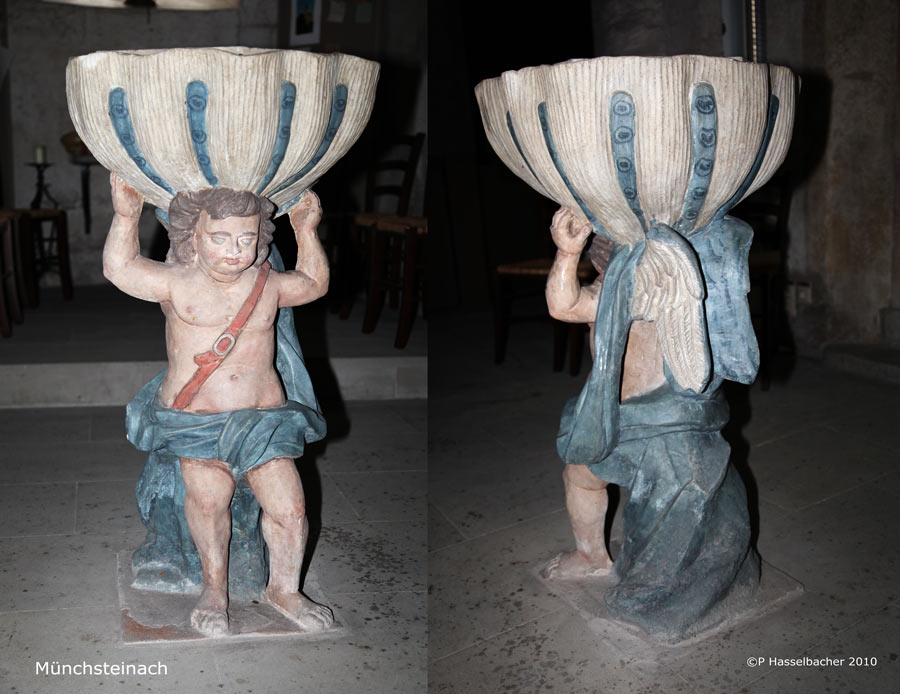Baptismal Fonts of the Aischgrund
Many of the Hazelbaker branch of the family will be familiar with the baptismal font pictured just below. It stands today in the church at Münchsteinach, the village in which their patriarch Peter was born. Some assumed the comfortable mythology that Peter himself was baptized at this font. The connection is a charming one and I actually felt badly having to debunk that story.
During my last trip to Germany, I was able to follow a historical trail of taufbecken or baptismal fonts [tauf= baptism; Becken= basin] across 106 km and 300 years. The Hazelbakers (and all the other Hasselbachers) will be pleased to learn that there is still a definite connection between our family and the Taufbecken at Münchsteinach. The connection is through Peter's brother, Balthasar; and it links both major branches of the American Hasselbacher family together. I prepared an audio visual supplement to these pages that can be viewed on YouTube.
For virtually all of the story I am indebted to the retired Pfarrer Italo Bacigalupo. For many years, Pfarrer Bacigalupo served a parish near Münchsteinach and had an interest in history. He wrote an article about Balthasar that was reported in a local newspaper that was sent to me by a German relative. The manuscript has been available in badly translated form on my website for some time. Until recently, its secrets were hidden from me by my ignorance of the German language. Last month, Pfarrer Bacigalupo graciously agreed to accompany me on a road trip to Alladorf to visit Balthasar's own Taufbecken, and to teach me something about the history of the region. I tell this story below.

Taufbecken of Münchsteinach
Above is a photograph of the Taufbecken from Münchsteinach. It sits in an alcove just to the side of the sanctuary. It is made of painted sandstone and depicts a winged Angel holding the baptismal bowl on its shoulders. The angel has the look of a "putto" or child-angel. It is my understanding that this genre of baptismal fonts is named Taufatlant, with an Engelatlant (Angel-Atlas) holding the Becken on his shoulders as Atlas held the globe. The belt makes me think of a Hercules.
This Taufbecken is attributed to Christoph Rendel and is dated from 1776, an important year for us Americans. Because Peter Hasselbacher was born in 1759, neither he nor any of his siblings could have been baptized in the embrace of this angel. However, all of Balthasar's children (from 1779 through 1794) might well have been baptized in it. Every time I have seen it over the past 6 years it has contained sand and a candle, but I am informed that the font is still in use for its original sacramental purpose.
Peter's brother Balthasar was trained as a Drechsler and wood carver (presumably Peter would have also been so trained). Balthasar created a number of religious objects for Münchsteinach and other nearby churches. For the church in Stübach, he carved from wood a Taufbecken modeled after this one from Münchsteinach. Balthasar's Taufbecken had an elaborate carved wooden cover depicting Christ, and with an inscription on top naming the sponsor of the piece and a date.
His font remained in the church in Stübach along with other prominent pieces carved by Balthasar until 1965 when it was passed to the church in the tiny village of Alladorf. As I understand the story, the Pfarrer and/or the congregation of the Stübach church were less than enthusiastic about its ornate style. I, however, feel a special connection to both the Taufstein (Stein= stone) and its maker because earlier in the 18th century Stübach was the home of my direct ancestor, Paulus Hasselbacher, about whom much will be written.